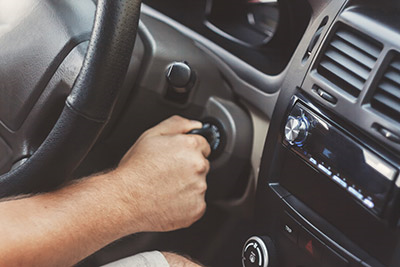Signs of a Bad Starter

In the old days, engines were started by a hand-crank that had enough force to break an arm. Eventually car starters were invented to handle this task. Today, there are a few different kinds of starters but all bad starters display similar signs and symptoms when defective. This article will cover the signs of a bad starter, why they fail, and how to diagnose a bad starter yourself.
1. Car Won’t Start
Considering the starter’s role in starting the engine, one of the most common signs of a bad starter is the car not starting. This can manifest in a few ways:
Dashboard Lights Turn on but not the Engine
If the car doesn’t start but the dash lights up when the key is turned to the on position, the problem is most likely not with the battery and may be the starter.
“One Click” Sound
When trying to start the car, if the vehicle does not start but you hear a single click sound like the one displayed in the video below, it is likely from a bad starter.
Chattering Sound
Also displayed in the video below, you may hear a chattering sound when trying to start the vehicle. This is more likely the battery, but it could be the starter if the battery is fine.
NOTE: If the vehicle is your daily driver and suddenly won’t start, there’s a good chance it’s the starter. If the vehicle history is unknown, it could be a different problem, like a seized engine.
2. Slow to No Engine Crank
Another symptom of a bad starter is the engine cranking slowly or not at all. If the engine fails to crank at all but you can hear the starter motor spinning, something is keeping the pinion from engaging properly. It could be from broken teeth in the starter or on pre-engaged starters, the solenoid.
If the engine is cranking like normal but not starting, it’s probably not the battery or the starter.

What Causes Starters to Fail?
Starters may fail to work due to either damage to the pinion, malfunctioning of the electrical parts, or the internal gears if it’s a gear-reduction starter. Generally, you can expect a starter to last for a long time. A starter replacement on a low mileage vehicle is unusual.
Worn Pinion Gear or Ring Gear
If the pinion gear has worn or broken teeth, it may not mesh properly with the ring gear and won't spin the flywheel fast enough to get the engine started. Worn or broken teeth on the ring gear may also cause this problem.
Overheated or Malfunctioning Internal Electrical Parts
To keep the starter small, the electrical components inside are not really designed for heat resistance, so the starter can only run for a brief period. Cranking the engine for too long (perhaps because you read somewhere that you can move the car with the starter), or not resting the starter before cranking it again can overheat the brushes that carry current to the armature or the wiring in the starter. If this occurs, the armature may not spin fast enough to get the engine started.
The electrical components can also simply wear out over time. This is more likely in vehicles that are frequently turned off and restarted, like delivery vehicles.
Engine Kickback
Problems with the ignition timing could also cause the engine to kickback. Just as kickback injured people on the old hand-crank cars, kickback can damage the starter.
How to Start a Car with a Bad Starter
If you need to move the vehicle momentarily, you might be able to get the starter to work by tapping it a few times with a hammer while an assistant starts the vehicle. This will allow the brushes inside the starter to get better contact, which might engage the starter. To see this in action, check out the video below.
How to Diagnose a Bad Starter
1. If the engine isn’t turning, first confirm the problem does not lie with the battery or the fuses. The battery can be tested and should read at least 12.6 volts. If not, you may have a bad battery.
2. Check the fuses with a test light to confirm the problem does not lie with a fuse. If there is a blown fuse, the problem probably won’t be solved by replacing it. The starter may be drawing too much amperage or there may be a shorted wire.
3. Once the battery and fuses have been confirmed to be working, locate the starter, which usually sits underneath the vehicle near the engine and transmission. You can test the starter’s electrical connections a few ways:
a. Connect a test light to a ground and the power wire and see if there’s electricity.
b. Connect a ground wire to the ignition switch electrical connector or ignition switch bolt/nut and run it to the test light. Ground the test light to the negative battery terminal. Start the vehicle. If the electrical connections are getting power, then the problem is with the starter and it will need to be replaced.

